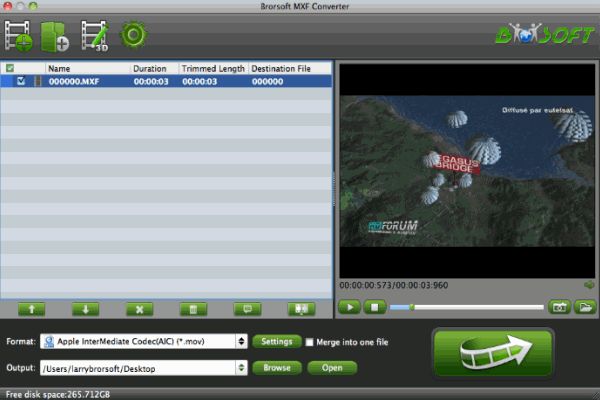Canon EOS C300 Mark II uses Canon's new XF-AVC codec to record video files and package them in an .MXF wrapper. The XF-AVC uses the MPEG-4 AVC/H.264 video compression format, efficiently recording 4K, 2K and HD video to regular memory cards while achieving a high data compression rate and preserving image quality, which is much difficult for Premiere Pro CC, CS6, CS5 to recognize and support.
If you accidentally meet with the problem, the best solution is to convert MXF to MPEG-2, the format which is proved to be the most compatible one with all the Adobe products, including Adobe Premiere Pro CS6. The most important part is how to find out the best MXF Converter among so many options on Google and Bing.

Brorsoft MXF Converter for Mac is best choice to get the work done. It lets you transcode 4K MXF to MPEG-2, Apple InterMediate Codec, Apple ProRes, DNxHD and more. This is a smart tool specially designed for MXF users to preview and convert 4K, 1080p MXF recordings to your wanted video and audio formats, so as to smoothly add them into Adobe Premiere Pro, iMovie, FCE, FCP, Avid Media Composer to do further editing. If you have MXF editing issues on Windows PC, get the MXF Converter to solve the problem.
Full Guide: Encode Canon C300 Mark II 4K XF-AVC/H.264 MXF to Premiere Pro CC/CS6/CS
Step 1: Add MXF files to the converter
Launch Brorsoft MXF Converter for Mac, and click the “Add Files” button to load 4k or 1080p .mxf videos for converting.

Step 2: Choose Premiere friendly format
Click “Format” bar and then move your pointer Adobe Premiere/Sony Vegas –> MPEG-2(*.mpg) as target format. Besides, you can also choose WMV (VC-1) (*.wmv) if you want to get a relatively smaller output file.
PS: You also can click “Settings” to set video frame rate, video size and Video Bitrate as you want.
Step 3: Start Canon C300 MK II MXF conversion
As soon as all things are finished, please click “Convert” button to start the Canon C300 Mark ii MXF to Premiere Pro conversion on Mac OS X.
Once the conversion is 100% completed, you can copy the converted Canon C300 MK II (4K) files to Premiere Pro CC/CS6/CS5/CS4 with smooth workflow.
Additional Tips:
This versatile MXF to Premiere Pro Converter allows you to convert MXF video to kinds of NLEs; just choose a proper output format. If you want to edit MXF media in Final Cut Pro, please choose the “Final Cut Pro > Apple ProRes 422 (*.mov)” as output; For iMovie or FCE 4, choose the “iMovie and Final Cut Express -> Apple InterMediate Codec (AIC) (*.mov)”. For Avid MC, choose “Avid Media Composer > Avid DNxHD(*.mov)”.
More Guides:
Convert MXF to MOV
Convert MXF for Mac editing
Convert MXF to AVI/WMV/MPEG
Canon XF Plugin for Final Cut Pro (X)| FAQs & Answers
How to Convert Canon MXF for Sony Vegas further editing
How to Transcode Canon MXF to DNxHD for Avid Media Composer
the recommended suggestion is to change MXF to a Premiere Pro more edit-friendly video format like MPEG-2 initially.
ReplyDeletehttp://working-with-4k-ultra-hd-videos.tumblr.com/post/140605353494/import-and-edit-canon-c300-mark-ii-4k-mxf-onto
I use iDealshare VideoGo to convert canon c300 files to fcp supported apple prores,
ReplyDeleteHere is the step by step guide
https://www.idealshare.net/imovie-fcp/import-canon-c300-to-fcp.html
Avdshare Video Converter can Convert Canon C300 recorded MXF videos to any version of Premiere more friendly MPEG-2 video for successfully importing the Canon C300 recorded videos to Premiere for editing.https://www.avdshare.com/import-canon-c300-footage-into-premiere
ReplyDelete